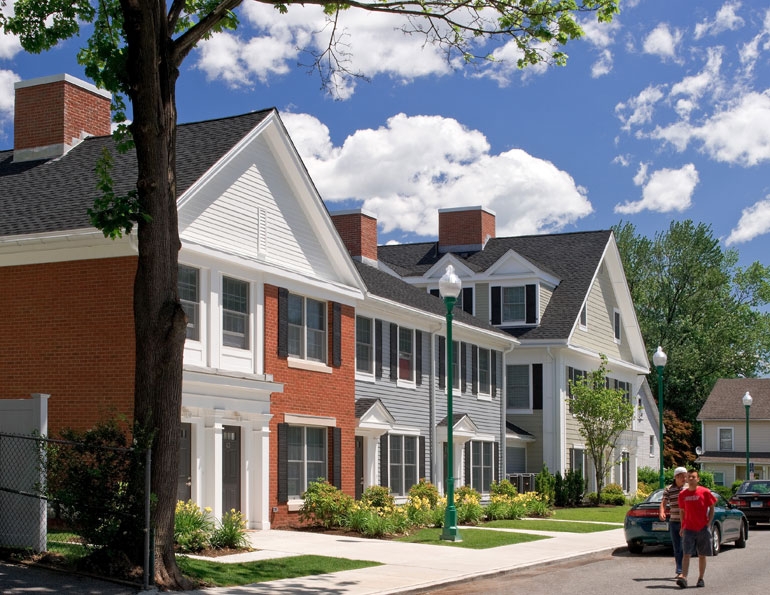Post From Community Close Ups
In the early 2000s, Stamford Hospital began planning a major expansion. Located in Stamford, Connecticut’s West Side neighborhood, the 305-bed regional hospital envisioned a large new state-of-the-art addition to its facility. The hospital owned various pieces of real estate in the nearby neighborhood, but none were contiguous with its existing campus. Meanwhile, Charter Oak Communities (COC), a public-private entity that evolved out of the Stamford Housing Authority, was exploring ways to replace its outdated public housing complexes on the West Side.
Project Components: Mixed-use development and mixed-income housing, community farm, major hospital revitalization, public green space, improved active, public and vehicular transportation
Key Stakeholders: Charter Oak Communities (COC), Stamford Hospital, City of Stamford, Stamford Community Collaborative, residents and property owners
Financing: U.S. Department of Housing and Urban Development, Low Income Housing Tax Credits, private equity, city grants, state capital funding, permanent debt, developer equity, hospital equity and hospital community benefit
Project Status: Launched in 2011, the community farm and six of seven new housing communities are complete with the hospital expansion to open in 2016
Scale: Neighborhood-scale redevelopment including a $186 million 390-unit mixed-income housing project in seven separate neighborhoods and a $450 million hospital expansion
Now called the Vita Health & Wellness District, this revitalization effort embodies the hospital’s emerging vision of and commitment to population health in one of the city’s most in-need neighborhoods, and it builds upon COC’s growing understanding of the range of resources, beyond housing, that a community needs. Both a place and an initiative, the Vita Health & Wellness District combines major physical revitalization of the West Side, anchored by the new mixed-income housing complexes and the $450 million hospital expansion, with the strategic improvement and addition of programming and services aimed to help the neighborhoods and the residents thrive.
Vita will include a new hospital campus designed to be architecturally open and integrated with the surrounding community. The campus will house new wellness-oriented facilities, programming, and services. Fairgate Farm, a community-run urban farm established in 2011 by COC and the hospital, sits near the new hospital wing and provides access to healthy foods while serving as a cornerstone for community involvement.
The Vita Health & Wellness District combines major physical revitalization with the strategic improvement of programming and services, to help the neighborhood and its residents thrive.
Streetscape enhancements and improved transportation options will create a more walkable and economically vibrant neighborhood, leading to better community health and stronger local businesses. Transportation serving a range of users and needs will also reconnect the West Side with Stamford’s downtown, an important job center. Norwalk Community College, in partnership with Stamford Hospital and with other local colleges and universities, will establish the Vita Health Sciences Institute, located in a new multiuse building near the hospital and offering vocational training in the health fields. The nearby high school will offer health career related courses, and Vita will help link residents to employers and job opportunities.
Local businesses will be offered one-on-one technical assistance in business development to help them succeed in the changing neighborhood and attract new clientele from the expanded hospital campus. They’ll also receive guidance to develop healthier menu offerings in keeping with the Vita theme. The two federally qualified health centers (FQHCs) that currently serve the West Side will continue to provide much-needed access to medical care, and will partner with the hospital and COC on prevention programming and improving overall community health.
A number of factors, in addition to the land swap, coalesced to make Vita happen. Previously, Stamford Housing Authority had received two HOPE VI program grants from the U.S. Department of Housing and Urban Development (HUD), including $20 million in 2004 for work in this neighborhood. HOPE VI not only emphasized de-concentrating low-income public housing by shifting to mixed income development, it also mandated that supportive programming and services be integrated into redevelopment efforts.

Photo/Charter Oak Communities
Tufo credits HOPE VI for laying the groundwork for a more holistic and comprehensive type of community revitalization. “We were incentivized to think about partnering with other community service organizations, like human services, job training, economic development,” he says. “We started to think about how we would help improve the self-sufficiency of public housing residents.” These learnings from HOPE VI meant that once conversations with the hospital were underway, COC was primed to consider the importance of health, and addressing the social determinants of health, as part of its work in the West Side.
For the hospital’s part, the 2010 passage of the Affordable Care Act (ACA) was an important catalyst for establishing Vita because of its emphasis on prevention and population health. One requirement, that the hospital conduct regular Community Health Needs Assessments (CHNAs), proved to be particularly important. The results of the 2012 CHNA highlighted that the city’s unhealthiest neighborhoods – those with disproportionate rates of chronic conditions such as diabetes, heart disease, and cancer – were in the two census tracts comprising Stamford’s West Side, right next to the hospital. Many people in the neighborhood lacked health insurance, not to mention primary care providers, and many relied on emergency room care or, more often, simply failed to get care at all.
The West Side community itself also had previous experiences that helped lay the groundwork for Vita. In 2005, the West Side NRZ (Neighborhood Revitalization Zone) was formed to develop a master plan for the neighborhood. The process included in-depth community engagement, bringing together community residents, owners of small local businesses, non-profits working in the area, elected officials, and other stakeholders to explore what the community’s aspirations were for its neighborhood. The West Side NRZ secured a “Village Commercial District” zoning designation from the city for the West Side and built a strong tradition of resident involvement in planning the neighborhood’s future.
Addressing the social determinants of health could provide a frame for managing the neighborhood transformation in a way that supported and strengthened the existing community.
As COC and Stamford Hospital continued their land swap conversations, the partners recognized that the enormous investments in the area from the hospital expansion and housing redevelopment would bring about a major transformation in the neighborhood. In particular, as Stamford Hospital’s Director of Public Affairs Pam Koprowski puts it, “we realized that just plunking the hospital down and plunking in new housing wouldn’t necessarily improve the lives of people who lived in the neighborhood.” She explains, “We wanted to make sure this was managed in a way that would give opportunity to the people who are in the neighborhood, achieving a re-balancing of the neighborhood instead of gentrification.”
The CHNA findings provided an “aha” moment that helped guide the way. Addressing the social determinants of health could provide a framework for managing the neighborhood transformation in ways that would support and strengthen the existing community. The Vita Health & Wellness District was born, rebranding the West Side and making health and wellness a foundational theme for a broad-based neighborhood revitalization effort.
To help bring Vita fully to fruition, in 2013 COC and Stamford Hospital formed the Stamford Community Collaborative, inviting 12 organizations, including health, human services, and youth development organizations, a local community college, and the West Side community (through the West Side NRZ), to become core strategic partners. In August of 2013, the group produced a plan for the Vita Health & Wellness District, mapping out the components of this health-focused, whole-neighborhood effort. COC and the hospital partner to serve as a “community quarterback” for Vita, and the hospital provides some financing and substantial staffing as part of its community benefit requirements.

Photo/Charter Oak Communities
Fast forward to 2016. In the nearly 15 years since COC and Stamford Hospital embarked on their respective redevelopment and expansion plans, six of the seven mixed-income housing complexes have been built and are occupied, while the hospital expansion is on schedule for a grand opening later in 2016. In the new mixed-income housing, market-rate and subsidized units are indistinguishable. The townhouse building design has increased public safety by giving residents “defensible space” — each unit has its own distinct façade and front door. The bay windows and front stoops facing the street provide “eyes on the street” that naturally discourage illicit activity. Energy Star construction makes the new housing highly energy-efficient. Healthy housing design minimizes exposure to toxins from construction materials and reduces exposure to asthma triggers and other health hazards.
Fairgate Farm continues to serve as home base for activities such as nutrition and cooking classes and yoga for community members, including children and teens. In the words of Farm Manager Bill Callion, Fairgate Farm is a “nucleus of change” in the community.
Future development phases include a welcoming tree-lined entry to the new hospital building off the West Side’s revitalized commercial corridor. This park-like area will also include access to a fitness center that is open to the public and other wellness services from the hospital. A shared parking garage will accommodate hospital employees as well as customers of the local businesses along a more pedestrian-friendly Stillwater Avenue.
The Vita project demonstrates how a hospital can fulfill the ACA’s mandate to engage its community by partnering to address the social determinants of health. And it exemplifies how a forward-thinking community development organization can partner with the health sector to pursue comprehensive community revitalization that it could not have achieved alone. These are still early days in what promises to be a fruitful and long-lasting partnership.
The anchor partnership driving the Vita Health & Wellness District revitalization is the one between COC and Stamford Hospital. In 2013 these partners founded the Stamford Community Collaborative, inviting 12 additional organizations working in the area to come in as core members to lead the strategic planning and implementation of Vita. COC and Stamford Hospital, together, serve as the community quarterback for the neighborhood revitalization process and are the backbone organization for Stamford Community Collaborative’s collective impact approach to the work.
The hospital provides significant in-kind staffing to help manage the collaborative’s work, thereby fulfilling some its community benefit requirement as a non-profit hospital. Beyond the collaborative’s core members, other organizations and entities partner to provide specific programming or services.
Members of the collaborative and other partners all have important roles to play in actualizing their collective vision. To guide that work, the Stamford Community Collaborative developed a tool, the Vita Impact Grid, that identifies program opportunities and service gaps, and outlines the outcomes that the partners have agreed will create a healthier community. The grid maps desired results (such as walkability or economic opportunity) to Vita’s primary initiatives (such as public housing revitalization or job development).
In his research of best practices from other hospital community involvement around the country, Tufo says he learned that such efforts are more likely to thrive with a reliable source of ongoing operating income, “They tend to become less successful and less sustainable over the long run if the ongoing effort is totally dependent on sporadic grant funding.” For the Vita project, this meant developing a housing mix that provides revenue to support other aspects of the project. In addition, the hospital will be able to claim its modest financial support and significant in-kind staffing support of the Vita work as part of meeting its IRS community benefit requirements. These continuing resources are important to sustaining the collaborative’s work together.
COC is building the West Side’s new mixed-income housing using a financing mix that includes Low Income Housing Tax Credits (LIHTC) received through the state housing agency, grants, and both public and commercial loans. Connecticut’s strong affordable housing program provides support for the acquisition of property and the building of new units. The City of Stamford provided additional loan and grant funding. Because 40 percent of the housing units are market-rate and Stamford is a high-cost housing market, Tufo explained that the market-rate units will help subsidize development and support debt repayment on the loans. In addition, the market rate units will provide an ongoing income stream to COC that will support programs and services, costs associated with Fairgate Farm, and fund additional housing construction in the future.
Acknowledging that COC did not use the services of a Community Development Financial Institution (CDFI), Tufo explains that the function was filled in-house, thanks to COC’s origins as the Stamford public housing authority.

Photo/Charter Oak Communities
For its expansion, Stamford Hospital sought $250 million in bonds and mounted a capital campaign to raise philanthropic funds.
Beyond financing the brick-and-mortar changes and formal programming and services, the collaborative bolsters and coordinates the community’s own resources. Fairgate Farm, for example, is operated by volunteer labor, which is coordinated by professional farm management and outreach services. “[Operation of] Fairgate Farm is a 100 percent volunteer effort,” says Tufo, “with the community investing their sweat equity.” The hospital provides nutritional education programs in kind, while COC covers the costs of the farm administration. From the outset, the Farm was envisioned to exist as an effort of the community, not as an embedded program or service. Says Tufo, “[The Farm] is a metaphor for all of our programs – Vita hopes to build community investment and resident empowerment into all of our initiatives.”
The Stamford Community Collaborative wants to move away from measuring outputs – e.g. number of units or square footage built, flu shots administered or health fair attendees – and toward measuring changes in actual health and well-being at the neighborhood level as a result of Vita. The collaborative has established a committee focused on identifying relevant outcomes measures.
This committee is exploring whether Vita could align its outcome measures with the goals established by the state in its Healthy Connecticut 2020. Goals include targets for reducing obesity and diabetes and addressing substance abuse and mental illness. While exploring how to track such changes and establish their relative importance, Tufo notes that these are long-term in nature. Nearer term, the collaborative wants to see preschool-aged children of undocumented immigrants in the community enter grade school ready to succeed. The collaborative is implementing a “Parents As Teachers” curriculum to support early cognitive development. The three-year program is being developed with assistance from Harvard Business School Community Partners.